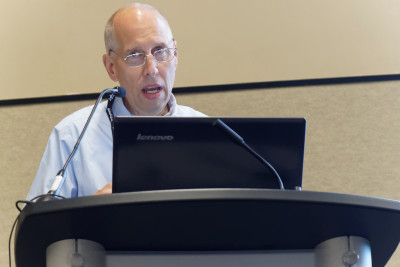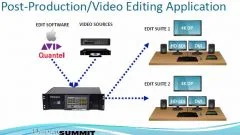
The second day of the Display Summit started with a session moderated by our own Bob Raikes that covered connectivity, especially the impact of UltraHD/4k content. The first speaker was Bob Ventresca who is from Thinklogical and he started by saying that there are challenges to getting all the ultraHD content moved around. It’s all about finding the right tool for the right job.
The amount of bandwidth for moving all this video is a real challenge – people in theme parks are already looking for UltraHD at 120Hz and that needs a very high bit rate. There are limitations in distance with HDMI, DisplayPort etc and this means other solutions need to be found.
ThinkLogical makes KVM solutions and Ventrusca explained ‘the basics of KVMs’ but mainly, he said, it’s about moving computers away from the people that operate them. This is important for security, as you can take users away from the physical PCs and USB ports. That means that they can’t simply copy files and data onto thumb drives. It also allows redundancy for life & death critical applications such as air traffic control.
Ventresca then looked in more detail at the ThinkLogical technology. The system is agnostic about content – it is passed transparently at up to 6.25Gbps or 10Gbps (it has two platforms). For some truly life-critical applications, you really need fast fallover between systems.
You can use IP-based architectures, but ThinkLogical uses a proprietary protocol which means that latency is up to 50ms – it is basically latency free. Looking at the pros and cons, the use of codecs can make it easier to send a lot of data but adds latency or artefacts. One of the applications of KVMs is in drone piloting and there, latency is a real issue.
At NAB, Ventresca said that there was lots of talk of accessing multiple sources “any to any” switching and his system can support switching multiple application suites to different desks.
He gave an example of a theme park operator that has a studio in Connecticut that is ready for 4k and probably even 8k as it has 1100 miles of fibre in its studio.
His next example was EFilm, which is a post-production house and put in a remote KVM system to avoid travel across LA. While Hollywood is used for filming, Santa Monica is the location for post-production and remote editing. There is over 15 miles of fibre in the application and the main aim is that content can be shared between the two locations without any difference in functionality and with no latency.
The use of the ThinkLogical system and optical fibre means that content can be secured. Security is also an issue in defence – ensuring only classified material is seen by authorised users.
Thes days, ships are “fly by wire” – they are driven by an operator using a video screen and a joystick. Navy ships have Port/Starboard redundancy so that if there is damage to one side, the other can be used. Fibre is also non-corrosive which is good in a marine environment and you can’t eavesdrop.

